
Pietro Perugino, an Italian Renaissance painter of the Umbrian school, developed some of the qualities that found classic expression in the High Renaissance. Raphael became his most famous pupil.
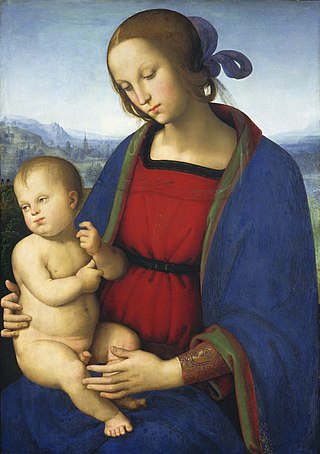
Madonna and Child is an oil on oak panel painting by Perugino. It dates to around 1501 and is now in the National Gallery of Art in Washington.
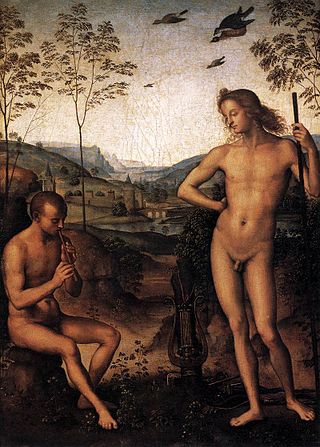
Apollo and Daphnis is a c.1483 mythological painting by Perugino. It was sold to the Louvre in Paris in 1883, where it still hangs and in whose catalogue it was known as Apollo and Marsyas. By the 1880s it had become misattributed to Raphael.

The Sant'Agostino Altarpiece is a painting by Perugino, produced in two stages between around 1502 and 1512 and then around 1513 to 1523. The altarpiece's 28, 29 or 30 panels were split up during the Napoleonic suppression of religious houses - most of its panels are now in the Galleria Nazionale dell'Umbria in Perugia. It is notable as the painter's last masterwork before he moved into his late phase producing more provincial commissions.

Madonna della Consolazione is an oil on panel painting by Perugino, datable c. 1496–1498. The work, completed in April 1498, was carried out in the Sala delle Udienze of the Collegio del Cambio. Since c. 1820 it is preserved in the National Gallery of Umbria in Perugia.

Crucifixion is a painting of the Crucifixion of Christ, usually attributed to Perugino, with or without assistance from Luca Signorelli. The work's dating and attribution are both uncertain - Venturi and Schmarsow attribute it to a pupil of Perugino, whilst other art historians attribute it to Perugino alone or with assistance from Signorelli. The deep chiaroscuro is comparable to Signorelli's style elsewhere or to the early style of Perugino whilst he was still heavily influenced by Verrochio. The landscape background is typical of Perugino, with mountains and hills in deep perspective.

Nativity of the Virgin is a small painting in tempera on panel by Pietro Perugino, dating to around 1472. It is held in the Walker Art Gallery, in Liverpool. It shows the nativity of Mary. The style of the house is heavily influenced by Andrea del Verrocchio.

Miracle of the Snow is a painting in tempera on panel by Pietro Perugino, dating to around 1472–1474 and now in the collection of Polesden Lacey. It shows the miraculous fall of snow which marked the spot for the foundation of Santa Maria Maggiore in Rome in 352. The painting belongs to Perugino's early period and the important commissions he gained during the short time he was active in Florence. Both it and the Nativity of the Virgin are usually identified as one of two surviving parts of the same predella, either from a lost altarpiece of the Virgin Mary or from the Pala di San Martino a Strada by Andrea del Verrocchio's studio. Both predella panels were in the Pucci chapel in Santissima Annunziata in Florence by 1786, when they were bought by John Campbell. They were sold to different owners in London in 1804, with the Miracle entering the Polesden Lacey collection.

Mary Magdalene is an oil on panel painting of Mary Magdalene, dating to around 1500 and now in the Galleria Palatina in Florence - it has featured in its inventory since 1641. It is now attributed to Perugino. It is modelled on his wife Chiara Fancelli, who also modelled for several of his Madonnas. It is comparable to his Madonna and Child with St John the Baptist and St Catherine of Alexandria (Louvre), of similar date and with a similar dark background.
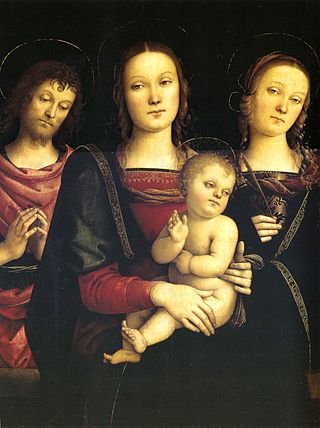
Madonna and Child with St John the Baptist and St Catherine of Alexandria is a c. 1495 oil on panel painting by Perugino of the Madonna and Child with John the Baptist and Catherine of Alexandria. It is now in the Louvre in Paris.

Madonna and Child with the Infant John the Baptist is an oil on oak panel painting by Perugino, dating to around 1497 and now in the Städel Museum in Frankfurt-am-Main
Miracles of Saint Bernardino is a series of eight paintings in tempera on panel showing miracles associated with Bernardino of Siena. They date to 1473 and are now in the Galleria Nazionale dell'Umbria in Perugia.

Portrait of a Boy is a 1495 oil on panel portrait, now in the Uffizi in Florence. In the past it has been attributed to Lorenzo di Credi, Viti, Jacopo Francia, Raphael and others, but Giovanni Morelli's reattribution of it to Perugino is now widely accepted. Although the lack of a landscape background is unusual for this painter, the style is typical of his portrait technique.

The Monteripido Altarpiece is a double-sided altarpiece by Perugino, completed in 1502 for San Francesco al Monte church in Monteripido near Perugia. It is now in the Galleria Nazionale dell'Umbria in Perugia.

Saint Sebastian is a c.1495 painting of Saint Sebastian by Perugino, now in the Louvre collection. It was temporarily on display at the Louvre-Lens branch between 2012 and 2017. It is probably the work mentioned in the 17th century inventory of the Barberini collection in Rome, which was later dispersed. Several pieces from it were taken abroad during the 19th century, with St Sebastian being bought by the Louvre in 1896.
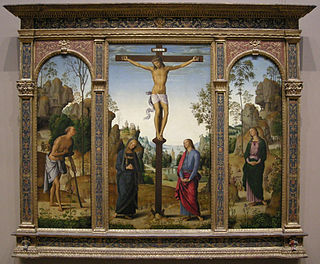
The Galitzin Triptych is a c.1485 painting by Perugino, now in the National Gallery of Art in Washington.

Madonna and Child with St Herculanus and St Constantius or Madonna of the Kitchen is a 1515 painting by Perugino, now in the Galleria Nazionale dell'Umbria in Perugia. Its title refers to the fact that it once hung in the former kitchen of the Palazzo dei Priori in Perugia. The two accompanying saints are Herculanus and Constantius, both local saints to Perugia.

Madonna and Child with St John the Baptist and St Augustine is a c.1494 painting by Perugino of the Madonna and Child enthroned between John the Apostle and Augustine of Hippo. It is in the church of Sant'Agostino in Cremona. It was commissioned in 1493 by the rich Roncadelli family, and the following year he painted it at his Florence studio before shipping it to Cremona. It is signed and dated on the throne Petrus Perusinus pinxit MCCCCLXXXXIIII.
Madonna and Child with St Peter and St Paul is a c. 1515 painting by Perugino or his studio, held in the Collegiata dei santi San Pietro e Paolo in Monteleone d'Orvieto. It shows the Madonna and Child between St Peter and Paul of Tarsus, with a semi-circular cymatium showing the Resurrection.
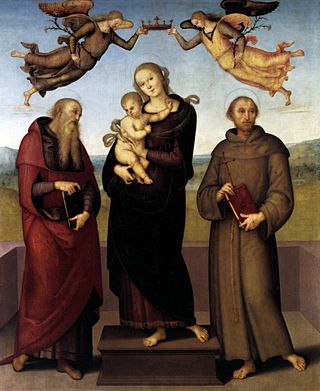
The Madonna of Loreto is a c.1507 oil on panel painting by Perugino, now in the National Gallery, London, which bought it in 1879. It shows the Madonna and Child flanked by Jerome (left) and Francis of Assisi (right). Two angels hover over Mary's head holding a crown. It reuses the low parapet from Madonna and Child with St Rose and St Catherine (1492) and probably also involved the master's studio assistants.



















